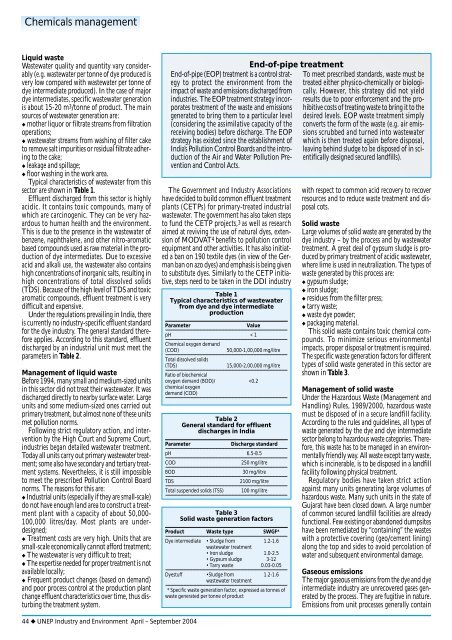industry and environment - DTIE
industry and environment - DTIE
industry and environment - DTIE
Create successful ePaper yourself
Turn your PDF publications into a flip-book with our unique Google optimized e-Paper software.
Chemicals management<br />
Liquid waste<br />
Wastewater quality <strong>and</strong> quantity vary considerably<br />
(e.g. wastewater per tonne of dye produced is<br />
very low compared with wastewater per tonne of<br />
dye intermediate produced). In the case of major<br />
dye intermediates, specific wastewater generation<br />
is about 15-20 m 3 /tonne of product. The main<br />
sources of wastewater generation are:<br />
◆ mother liquor or filtrate streams from filtration<br />
operations;<br />
◆ wastewater streams from washing of filter cake<br />
to remove salt impurities or residual filtrate adhering<br />
to the cake;<br />
◆ leakage <strong>and</strong> spillage;<br />
◆ floor washing in the work area.<br />
Typical characteristics of wastewater from this<br />
sector are shown in Table 1.<br />
Effluent discharged from this sector is highly<br />
acidic. It contains toxic compounds, many of<br />
which are carcinogenic. They can be very hazardous<br />
to human health <strong>and</strong> the <strong>environment</strong>.<br />
This is due to the presence in the wastewater of<br />
benzene, naphthalene, <strong>and</strong> other nitro-aromatic<br />
based compounds used as raw material in the production<br />
of dye intermediates. Due to excessive<br />
acid <strong>and</strong> alkali use, the wastewater also contains<br />
high concentrations of inorganic salts, resulting in<br />
high concentrations of total dissolved solids<br />
(TDS). Because of the high level of TDS <strong>and</strong> toxic<br />
aromatic compounds, effluent treatment is very<br />
difficult <strong>and</strong> expensive.<br />
Under the regulations prevailing in India, there<br />
is currently no <strong>industry</strong>-specific effluent st<strong>and</strong>ard<br />
for the dye <strong>industry</strong>. The general st<strong>and</strong>ard therefore<br />
applies. According to this st<strong>and</strong>ard, effluent<br />
discharged by an industrial unit must meet the<br />
parameters in Table 2.<br />
Management of liquid waste<br />
Before 1994, many small <strong>and</strong> medium-sized units<br />
in this sector did not treat their wastewater. It was<br />
discharged directly to nearby surface water. Large<br />
units <strong>and</strong> some medium-sized ones carried out<br />
primary treatment, but almost none of these units<br />
met pollution norms.<br />
Following strict regulatory action, <strong>and</strong> intervention<br />
by the High Court <strong>and</strong> Supreme Court,<br />
industries began detailed wastewater treatment.<br />
Today all units carry out primary wastewater treatment;<br />
some also have secondary <strong>and</strong> tertiary treatment<br />
systems. Nevertheless, it is still impossible<br />
to meet the prescribed Pollution Control Board<br />
norms. The reasons for this are:<br />
◆Industrial units (especially if they are small-scale)<br />
do not have enough l<strong>and</strong> area to construct a treatment<br />
plant with a capacity of about 50,000-<br />
100,000 litres/day. Most plants are underdesigned;<br />
◆ Treatment costs are very high. Units that are<br />
small-scale economically cannot afford treatment;<br />
◆ The wastewater is very difficult to treat;<br />
◆ The expertise needed for proper treatment is not<br />
available locally;<br />
◆ Frequent product changes (based on dem<strong>and</strong>)<br />
<strong>and</strong> poor process control at the production plant<br />
change effluent characteristics over time, thus disturbing<br />
the treatment system.<br />
End-of-pipe (EOP) treatment is a control strategy<br />
to protect the <strong>environment</strong> from the<br />
impact of waste <strong>and</strong> emissions discharged from<br />
industries. The EOP treatment strategy incorporates<br />
treatment of the waste <strong>and</strong> emissions<br />
generated to bring them to a particular level<br />
(considering the assimilative capacity of the<br />
receiving bodies) before discharge. The EOP<br />
strategy has existed since the establishment of<br />
India’s Pollution Control Boards <strong>and</strong> the introduction<br />
of the Air <strong>and</strong> Water Pollution Prevention<br />
<strong>and</strong> Control Acts.<br />
The Government <strong>and</strong> Industry Associations<br />
have decided to build common effluent treatment<br />
plants (CETPs) for primary-treated industrial<br />
wastewater. The government has also taken steps<br />
to fund the CETP projects, 3 as well as research<br />
aimed at reviving the use of natural dyes, extension<br />
of MODVAT 4 benefits to pollution control<br />
equipment <strong>and</strong> other activities. It has also initiated<br />
a ban on 190 textile dyes (in view of the German<br />
ban on azo dyes) <strong>and</strong> emphasis is being given<br />
to substitute dyes. Similarly to the CETP initiative,<br />
steps need to be taken in the DDI <strong>industry</strong><br />
Table 1<br />
Typical characteristics of wastewater<br />
from dye <strong>and</strong> dye intermediate<br />
production<br />
Parameter<br />
Value<br />
pH < 1<br />
Chemical oxygen dem<strong>and</strong><br />
(COD)<br />
50,000-1,00,000 mg/litre<br />
Total dissolved solids<br />
(TDS)<br />
15,000-2,00,000 mg/litre<br />
Ratio of biochemical<br />
oxygen dem<strong>and</strong> (BOD)/
















